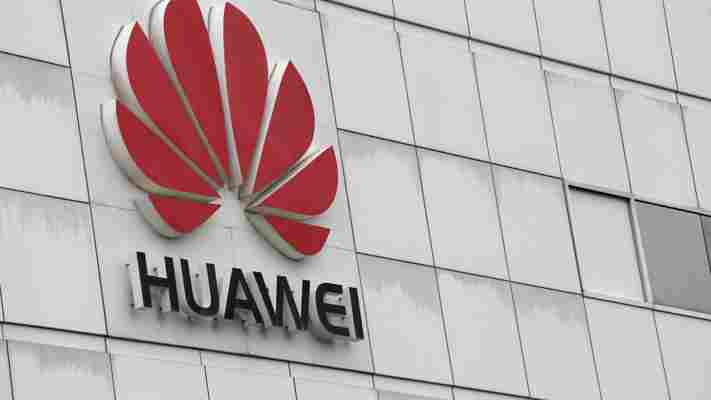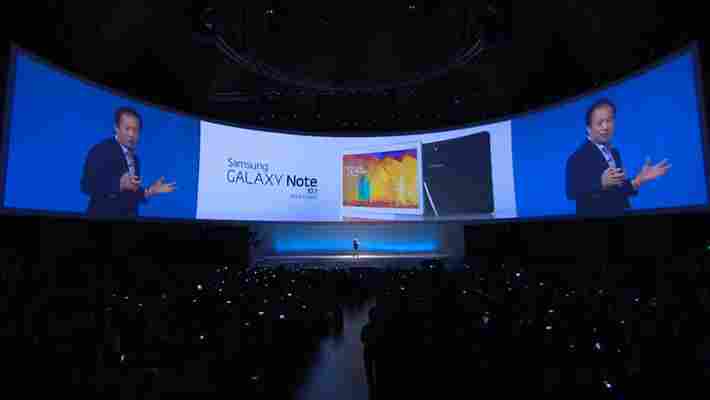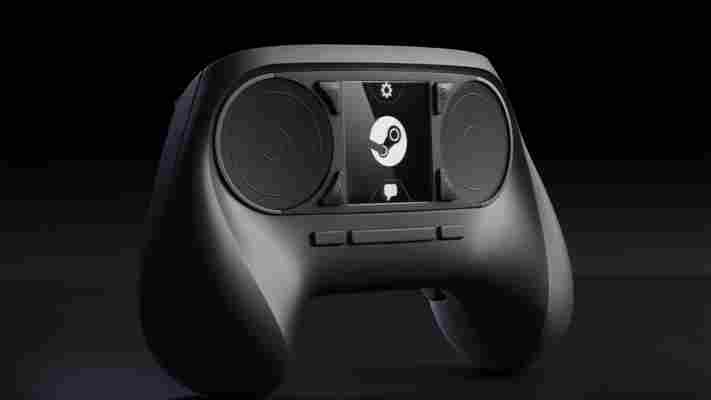Huawei today unveiled the Ascend P7, its latest top-end Android smartphone. At the company’s launch event in Paris, the new handset was revealed with a full HD 5-inch display, 1.8 GHz quad-core processor and 2GB of RAM.

The device is 6.5mm thick, which makes it “one of the slimmest” 4G LTE smartphones on the market, according to Huawei. It also comes with a 13-megapixel rear-facing camera, powered by Sony’s fourth generation BSI sensor, and an 8-megapixel shooter on the front. It’s capable of capturing 1080p video, but there’s no word on whether that stretches to 4K recording.
It weighs only 124 grams and comes with 16GB of onboard storage, alongside a 32GB MicroSD card slot. Huawei’s latest flagship also supports LTE connectivity and runs on Android version 4.4.2 (KitKat), albeit with the company’s exclusive Emotion UI skin layered on top. Based on the app icons alone, it’s clear Huawei has taken a few design cues from iOS 7.
Underneath the hood, you’ll find a 2,500 mAh battery powering all of its various components. Huawei has also integrated a “super power-saving mode” that means, with less than 10 percent of its total battery life, the device can still last another 24 hours on standby.
The Ascend P6 will be sold in the following markets for €449: China, the United Kingdom, Germany, Italy, France, Spain, Portugal, Ireland, the Netherlands, Belgium, Switzerland, Poland, Lithuania, Estonia, Latvia, Serbia, Greece, Norway, Hungary, Denmark, Slovakia, Czech Republic, Austria, Hong Kong, Thailand, Malaysia, Philippines, Singapore, Saudi Arabia, Kuwait, and the UAE.
A release date wasn’t disclosed, but Huawei confirmed it would be coming to other markets in the future. Based on its specs and price-tag though, it’s clear the Ascend P7 was envisioned as a more affordable premium smartphone. With Samsung, HTC, Sony and other Android OEMs competing at the high-end, this could give them a valuable point of differentiation.
The new flagship succeeds the Ascend P6 , which Huawei claimed to be the world’s slimmest Android smartphone at the time. At just 6.2mm it was certainly skinny, and in our early hands-on we were impressed by its refined industrial design and high-resolution front-facing camera.
Most recently, the Chinese smartphone maker attended Mobile World Congress to launch the 4G-enabled Ascend G6 smartphone and TalkBand B1 fitness tracker, as well as its Android-based MediaPad X1 and M1 tablets.
Featured image credit: Aaron Tam/AFP/Getty Images
Samsung announces Galaxy Note 10.1 2014 Edition tablet
Samsung has announced the 2014 Edition of its Galaxy Note 10.1 tablet. The device will feature similar internals and features to the just-announced Galaxy Note 3 phablet.

The Galaxy Note 10.1 includes a 2560×1600 WQXGA display, a 1.9GHz eight-core processor (or 2.3GHz quad-core for the LTE version) and 3GB of RAM. It is 7.99mm thick. The Wi-Fi version will weigh 535g, while the LTE version is 545g. The rear camera is an 8-megapixel shooter, while the front camera is rated at 2-megapixels.
Free “content gifts” bundled with the Galaxy Note 10.1 include offerings from The New York Times, Dropbox, Evernote and Bitcasa.
Samsung is also touting improved S Pen and S Note functionality on the Galaxy Note 10.1, as well as multi window and pen window multitasking features.
The firm unveiled the devce at its UNPACKED 2013 Episode 2 event at IFA in Berlin. Samsung also outed its Galaxy Gear smartwatch at the event.
Samsung plans will start shipping all three devices on September 25th, with worldwide availability coming in October.
The biggest challenges facing Steam Machines and how Valve can overcome them
Valve is a special company. As a video game publisher, it’s produced some of the industry’s most beloved and successful franchises including Half-Life , Portal and Left for Dead . As a software developer, it’s created Steam , the most successful digital distribution platform for Windows, Mac and Linux-based gaming.

Now, it wants to expand into the living room with a Linux-based operating system called SteamOS and dedicated hardware referred to as Steam Machines .
This new category of living room hardware could replace existing high-end gaming PCs, or just supplement them as a low-cost streaming solution. It’s an unusual marketing problem which Valve will need to overcome while keeping the price low and persuading game developers to support Linux.
When rumors of a Steam Box first emerged, the Internet anticipated a console that could open up PC gaming’s appeal to the wider public. No more compatibility problems, missing drivers or crashing to desktop. Just plug it into a TV, launch Steam in Big Picture mode and relax.
In this scenario, the Steam Box is a standalone product, with the capacity to replace any gaming PC that the player already owns. It resides underneath the TV, jockeying for position with other consoles such as the PlayStation 4 and Xbox One. While it’s possible that Valve could be developing its own Steam Box – the company has confirmed it’s working on a prototype – the focus appears to be on Steam Machines produced by hardware partners.
But there are some potential problems.
Challenge one: Price
A high-end gaming PC isn’t cheap. While it’s possible to build a custom rig for $500 , most will argue that you need to spend around $700 to get a competitive and reasonably future proof setup.
That’s a substantial difference over the upcoming PlayStation 4 ($399) and Xbox One ($499). Unlike Valve, Sony and Microsoft are large corporations with the ability to subsidize their respective systems, banking on the long-term revenue produced by software, services and advertising.
If the first wave of Steam Machines are more expensive than these two consoles and don’t offer a significant, noticeable improvement in performance, that could be a sizeable problem.
The benefits of Steam can’t be ignored; it could be argued that the savings made from all those crazy sales would cancel out the price difference over a system’s life-cycle anyway. Nevertheless, at this price point the wider public, those Valve are aiming for with the Steam Machines concept, will be deterred. The $100 price gap between the PlayStation 4 and Xbox One is already a point of contention; anything higher will be an even tougher sell for Valve.
Solution: SteamOS
The price of gaming PCs are bumped up by Microsoft’s desktop operating system, Windows. It’s difficult to put an exact figure on the cost of a Windows license, but it’s certainly a factor that contributes to the final sticker price.
Steam Machines will instead run SteamOS, a free Linux-based operating system developed by Valve. That could help keep the cost down and in turn, allow hardware partners to push the specs as high as possible.
That offset will be crucial. To succeed, Steam Machines have to offer high-end specs alongside an incredibly aggressive price tag. Superior performance to the PlayStation 4 and Xbox One, for only a marginal price increase, is the only way Valve can hope to compete.
Challenge two: Games
Gabe Newell, CEO of Valve and a former Microsoft employee, once described Windows 8 as a catastrophe . It’s therefore unsurprising to see the company push its own platform running on Linux. After all, SteamOS is potentially cheaper for Valve and will give them far greater control over the ecosystem and user experience.
The reliance on Linux could backfire though. At present, only a small number of games on Steam support Linux. Valve says it already has “hundreds” of games running natively on SteamOS, but that pales in comparison to the full Steam catalog sporting nearly 3,000 titles.
For new adopters, this shouldn’t be a problem. The PlayStation 4 and Xbox One will both have somewhere between 20 and 35 games in their launch-window lineup. SteamOS would therefore surpass this number with ease, even if most of its catalog is made up of older titles.
However, it could be difficult for Valve to sway players with Windows-based gaming PCs. Most PC titles are released exclusively on Windows (which, in terms of release dates, is usually a half-step behind the PlayStation 3 and Xbox 360 anyway). Unless Valve can trigger a monumental shift in developer support for Linux, SteamOS will always play second-fiddle to Windows.
In short, why would PC players give up their existing library on Steam for a smaller catalog on SteamOS?
Solution: Half-Life 3
One game. That’s all it would take. Half-Life 2 is considered to be one of the greatest video games of all time and the Internet is awash with fans clamouring for a sequel.
Some form of exclusivity for Half-Life 3, timed or otherwise, would give SteamOS and Steam Machines a massive lift. If Valve can supplement this with new content or instalments for some of its other franchises, such as Portal and Left for Dead, that level of furore would only be heightened.
Of course, there’s a balancing act here. Valve doesn’t want to discourage Windows and Mac users from adopting Steam in its current form, so a wider release for Half-Life 3 would be inevitable. But some form of early access, if executed correctly, could be huge.
An interesting part of SteamOS is its ability to stream games running from the standard Steam client. In theory, this means players who already have a gaming PC can keep their collection and access it free of charge in the living room.
It’s also a simple solution for the Linux issue, given that players will be able to maintain their existing and often expansive Window or Mac-based libraries.
In-home streaming points to a different portfolio of Steam Machines though. PC gamers are unlikely to pay for two high-end gaming rigs, so the industry is expecting a number of low-cost, underpowered boxes built exclusively for streaming. How will Valve differentiate between the two?
Challenge three: Messaging
A $700 Steam Machine built for high-end gaming and a $100-$200 streaming box similar to PS Vita TV are very different. One works as a standalone product, while the other requires a separate gaming PC.
Valve has already confirmed that Steam Machines will hit a range of different prices and specs, catering to different players and their individual preferences. All of this adds further variation to the SteamOS platform. The original idea for the Steam Box was unique because it had the capacity to standardize PC gaming, clearing away the confusion that often deters casual players from exploring and adopting the Steam digital distribution platform.
The sheer variety of Steam Machines could simply reproduce this problem. Is this a self-contained gaming machine, a streaming setup, or both? Does it run every game on SteamOS, or will gamers be unable to play the latest releases? What performance can they expect from this hardware?
Solution: Clarity
Valve needs to work with its chosen hardware partners to create a simple and clear way of explaining the SteamOS ecosystem.
One solution would be to try to standardize the components applicable for a certified Steam Machine. Rather like Apple’s finite range of Macs and spec upgrades, Valve could specify a number of preferred or required parts, making it easier for consumers to understand and compare different options.
In the same breath, a smaller number of SteamOS supported parts would also streamline the process of upgrading a Steam Machine. PC gamers might bristle at the idea of artificially restricted customization options, but this is how Steam Machines could and should differ from regular PCs.
After all, SteamOS hardware is targeting the living room and should focus on marrying performance with accessibility, rather than simply mimicking what is already available in the PC space.
Gaming hardware is undergoing an unprecedented level of convergence. The PlayStation 4 and Xbox One, running on x86 architecture, are similar to PCs. Valve, with SteamOS and Big Picture mode, is starting to make PCs more like the established video game consoles.
Valve has a huge opportunity to disrupt the status-quo and bring PC gaming into the living room. It needs to prove, however, that there’s a desire from consumers for a platform that’s as open and versatile as SteamOS. If it can’t resolve some of these fundamental problems, Valve will struggle to gain the support of developers and PC gamers, as well as the wider public.
